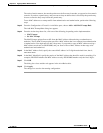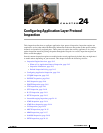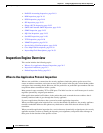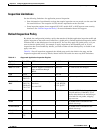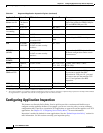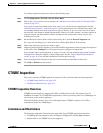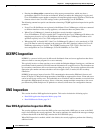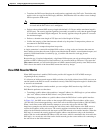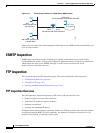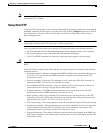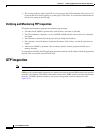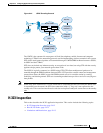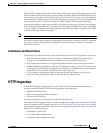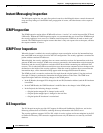
24-7
Cisco ASDM User Guide
OL-16647-01
Chapter 24 Configuring Application Layer Protocol Inspection
DNS Inspection
• Translates the DNS record based on the configuration completed using NAT rules. Translation only
applies to the A-record in the DNS reply; therefore, DNS Rewrite does not affect reverse lookups,
which request the PTR record.
Note DNS Rewrite is not applicable for PAT because multiple PAT rules are applicable for each
A-record and the PAT rule to use is ambiguous.
• Enforces the maximum DNS message length (the default is 512 bytes and the maximum length is
65535 bytes). The security appliance performs reassembly as needed to verify that the packet length
is less than the maximum length configured. The security appliance drops the packet if it exceeds
the maximum length.
• Enforces a domain-name length of 255 bytes and a label length of 63 bytes.
• Verifies the integrity of the domain-name referred to by the pointer if compression pointers are
encountered in the DNS message.
• Checks to see if a compression pointer loop exists.
A single connection is created for multiple DNS sessions, as long as they are between the same two
hosts, and the sessions have the same 5-tuple (source/destination IP address, source/destination port, and
protocol). DNS identification is tracked by app_id, and the idle timer for each app_id runs
independently.
Because the app_id expires independently, a legitimate DNS response can only pass through the security
appliance within a limited period of time and there is no resource build-up. However, if you enter the
show conn command, you will see the idle timer of a DNS connection being reset by a new DNS session.
This is due to the nature of the shared DNS connection and is by design.
How DNS Rewrite Works
When DNS inspection is enabled, DNS rewrite provides full support for NAT of DNS messages
originating from any interface.
If a client on an inside network requests DNS resolution of an inside address from a DNS server on an
outside interface, the DNS A-record is translated correctly. If the DNS inspection engine is disabled, the
A-record is not translated.
As long as DNS inspection remains enabled, you can configure DNS rewrite using a NAT rule.
DNS Rewrite performs two functions:
• Translating a public address (the routable or “mapped” address) in a DNS reply to a private address
(the “real” address) when the DNS client is on a private interface.
• Translating a private address to a public address when the DNS client is on the public interface.
In Figure 24-1, the DNS server resides on the external (ISP) network The real address of the server
(192.168.100.1) has been mapped using a static NAT rule to the ISP-assigned address (209.165.200.5).
When a web client on the inside interface attempts to access the web server with the URL
http://server.example.com, the host running the web client sends a DNS request to the DNS server to
resolve the IP address of the web server. The security appliance translates the non-routable source
address in the IP header and forwards the request to the ISP network on its outside interface. When the
DNS reply is returned, the security appliance applies address translation not only to the destination
address, but also to the embedded IP address of the web server, which is contained in the A-record in the
DNS reply. As a result, the web client on the inside network gets the correct address for connecting to
the web server on the inside network.



